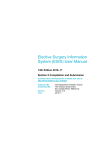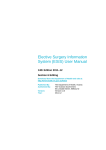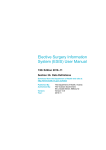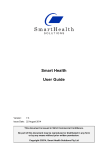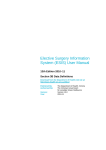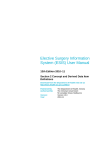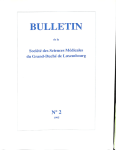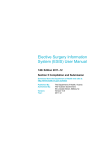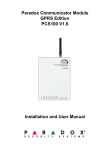Download Victorian Emergency Minimum Dataset (VEMD) User Manual
Transcript
Elective Surgery Information System (ESIS) User Manual 14th Edition 2011–12 Section 4 Business Rules Download from the Department of Health web site at: http://www.health.vic.gov.au/hdss/ Published By: Authorised By: Version: Year: The Department of Health, Victoria The Victorian Government 50 Lonsdale Street, Melbourne Version 14.0 2011-12 ESIS Manual Sections The Elective Surgery Information System (ESIS) Manual sections are: Glossary Lists the terms and abbreviations used in the ESIS manual. Section 1 ESIS Manual Introduction Provides information on the development and purpose of the ESIS data collection, data submission timeframes, scope and coverage, contact details and a list of relevant abbreviations. Section 2 Concept and Derived Item Definitions Section 3a Data Definitions - Data collection items Section 3b Provides definitions of concepts that are the foundation of the ESIS collection and information that the department derives from the data submitted. Details the specifications of data items relating to individual waiting episodes for reporting to ESIS. Data Definitions - Technical elements Details the technical or database elements required for submission of ESIS data. Section 4 Business Rules Section 5 Compilation and Submission Section 6 Editing Section 7 Supplementary Code Lists Draws together a number of concepts and data items as well as describing the technical functions of the ESIS processing. Specifies the required format of ESIS records submitted to AED. It includes details such as file naming conventions, file structures, reporting requirements, data security, test submission and system migration. Each ESIS edit message is listed in this section in numerical order. The entry for each edit message describes the problem and the remedy. http://www.health.vic.gov.au/hdss/reffiles/index.htm Contents SECTION 4: Business Rules 1 Introduction 1 Backdated data entry 1 Calculation of Total Waiting Time 2 Cancellations 7 Common Procedures not Considered Elective Surgery 8 Changing the PPP from an Excluded Procedure to an Included Procedure 10 Changing from an Included Procedure to an Excluded Procedure 10 Deletion 11 Intra Episode Events required for Registration 13 Merging Patient Identifiers 14 Patient Identifiers Merged in Error 15 Transfer of Ownership of Waiting Episode 16 Scheduling or Booking 17 Editing 20 Tabular business rules 24 Reason for Removal and Date of Admission 23 Reason for Removal and Destination 23 Reason for Removal, Date of Admission and Scheduled Admission Date 23 SECTION 4: Business Rules Introduction This section provides business rules associated with reporting to the ESIS data collection. The business rules for ESIS are varied and relate both to the various data items, as well as providing technical information associated with reporting to the complex ESIS data collection. Backdated data entry Software vendors must provide hospitals with systems that have the capacity for data entry of additions, changes or deletions for Episode and Intra Episode Events that have occurred at some point in the past. This is necessary where: a waiting episode has not been correctly entered. This will, on discovery, require the original Clinical Registration Date and all other relevant dates to be entered a waiting episode has been wrongly removed at some point in the past and requires reinstating an Intra Episode Event that has been overlooked. Refer to: Section 3a Clinical registration date Section 3b: Event Type ESIS Manual: 14th Edition – Section 4: Business Rules Page 1 Calculation of Total Waiting Time The rules for calculating waiting time are extremely complex, given the multiple combinations of events that can occur within a waiting episode. In summary, waiting time is the count of the number of days that an episode is Ready For Care between the start date and the end date. Step 1 – Start date Start date for calculation: The start date for the waiting time calculation is usually the Administrative registration date. Exceptions to this are: 1.When the Administrative registration date is after the removal date or after the admission date, in which case the clinical registration date is used. 2. If an urgency category has increased, then the start date is the date the most recent urgency increase occurred. Please note that this means that if a record has had an urgency increase then it will have different start dates for the purpose of the calculation depending on whether the census date for the calculation is before or after the urgency increase. Step 2 – End date End date for calculation: For records that are: a. not removed (ie Removal Date is either null or greater than census date) and not admitted (ie Admission Date is either null or greater than census date) at census date, then end date is the census date plus one day. b. admitted (ie Admission Date is <= census date and Reason For Removal is W, S, X, B, I, M, U or Y) on or before census date regardless of whether removed or not at census date, then end date is admission date. c. removed (ie Removal Date is <= census date) but not admitted (ie Reason For Removal is not null and not a value in number 2 above) at census date, then end date is removal date. End dates for b. and c. above are summarised in Table 1: Note: If any of the removal details are (removal reason/ date of admin) not present then the values that are present are ignored. Eg. See episode ESIS Manual: 14th Edition – Section 4: Business Rules Page 2 Table 1 Aggregation of Reason For Removal Admitted Other Admitted Planned Transfer Not Admitted Reason For Removal Code Reason For Removal Description End Date B Treated Elsewhere for awaited procedure at a public facility Admission Date I Treated Elsewhere for awaited procedure at a private facility Admission Date M Admitted for awaited procedure as emergency patient to this hospital Admission Date U Treated Elsewhere for awaited procedure - unknown whether public or private Admission Date Y Procedure received - neither planned nor emergency Admission Date W Admitted to this campus and has received the awaited procedure Admission Date X Hospital arranged admission at other hospital Admission Date S Treatment for proc arranged by ESAS Admission Date N Transfer to non-ESIS public hospital T Transfer to another ESIS campus/health service O Other reason for cancellation Q Surgery declined or not required R Died F Failure of Patient to arrive for treatment Z Not contactable Exception – i.e. what to do in case of erroneous data If Admission Date is blank or invalid for some other reason then substitute Removal Date Use Removal date for these removal reasons as there is no admission date Step 3 – Count the number of days between the start and end dates where the record is Ready For Care The waiting time is the count of Ready For Care Days between the start and end dates. An episode is considered as Ready For Care for the duration of time denoted by the intra-episode Readiness event record with a value of “R”. Step 4 – Increases in urgency category An increase in urgency category will reset the waiting time to zero. Counting of Ready For Care days begins at zero from the event date of the urgency increase. ESIS Manual: 14th Edition – Section 4: Business Rules Page 3 Refer to the following examples: Example 1 Clinical Reg Date: Admin Reg Date: Removal Date: Admission Date: Reason For Removal: 15 May 11 20 May 11 28 July 11 27 July 11 W (i.e. admitted as planned for awaited procedure) Intra-Episode Events for this record: Episode_ID Event_Type Event_Date SAD_Identifier 0000123456 Urgency 15052011 2 0000123456 Readiness 15052011 R 0000123456 Set SAD 26062011 00X 123456 Event_Value 27072010 For this record the waiting time calculation at the following census dates is: Census Date Waiting Time Explanation 31 May 2010 12 Count of days RFC from Admin Reg Date to Census Date inclusive OR (Census Date – Admin Reg Date) + 1 day. 31 July 2010 68 Count of Days RFC from Admin Reg Date to Admission Date as reason for removal is W. Example 2 Clinical Reg Date: Admin Reg Date: Removal Date: Admission Date: Reason For Removal: 20 July 11 20 July 11 31 August 11 26 August 11 W (i.e. admitted as planned for awaited procedure) Intra-Episode Events for this record: Episode_ID Event_Type Event_Date SAD_Identifier 0000567891 Urgency 20072011 1 0000567891 Readiness 20072011 C 0000567891 Readiness 24082011 R 0000567891 Set SAD 24082011 00X 456321 Event_Value 26082011 For this record the waiting time calculation at the following census dates is: Census Date Waiting Time Explanation 31 July 2011 0 For all days from admin registration date to census date, patient is not ready for care 31 August 2011 2 Record became ready for care on 24 August, reason for removal is W, admission date 26 August used. ESIS Manual: 14th Edition – Section 4: Business Rules Page 4 Example 3 Clinical Reg Date: Admin Reg Date: Removal Date: Admission Date: Reason For Removal: 24 Mar 11 24 Mar 11 null null null Intra-Episode Events for this record: Episode_ID Event_Type Event_Date SAD_Identifier Event_Value 0000345678 Readiness 24 Mar 11 R 0000345678 Urgency 24 Mar 11 3 0000345678 Readiness 28 Apr 11 P For this record the waiting time calculation is: Census Date Waiting Time Explanation 31 Mar 11 8 30 Apr 11 36 31 May 11 36 This record’s count of Ready For Care days is the number of days from 24 Mar to 28 April when the record became not ready for care. This record is not ready for care at the census dates on or after 28 April. Example 4 – Change in Urgency category Clinical Reg Date: Admin Reg Date: Removal Date: Admission Date: Reason For Removal: 31 Jul 11 31 Jul 11 27 Nov 11 27 Nov 11 W Intra-Episode Events for this record: Episode_ID Event_Type Event_Date 0000456789 Readiness 31072011 R 0000456789 Urgency 31072011 1 0000456789 Urgency 05082011 2 0000456789 Reason SAD Changed 14112011 0000456789 Readiness 14112011 C 0000456789 Urgency 14112011 1 0000456789 Readiness 20112011 R 0000456789 Set SAD 20112011 ESIS Manual: 14th Edition – Section 4: Business Rules SAD_Identifier 00X741258 00X963258 Event_Value C 27112011 Page 5 For this record the waiting time calculation is (just restricting to its last 3 months): Census Date Waiting time Explanation 31 August 11 32 Number of ready for care days between admin reg date and census date plus one. Urgency decrease does not alter waiting time calculation. 30 November 11 7 The urgency increase from 2 to 1 on 14 Nov 11 reset the starting point to zero. The patient was made ready for care on 20 Nov 11 and was removed on 27 Nov 11. This record has had seven ready for care days after the urgency increase. Example 5 – Administrative registration date is after removal date Clinical Reg Date: Admin Reg Date: Removal Date: Admission Date: Reason For Removal: 5 Dec 11 21 Dec 11 13 Dec 11 13 Dec 11 W Intra-Episode Events for this record: Episode_ID Event_Type Event_Date SAD_Identifier 0000654321 Readiness 05122011 R 0000654321 Urgency 05122011 1 0000654321 Set SAD 06122011 00X987654 Event_Value 13122011 For this record the waiting time calculation is: Census Date Waiting Time Explanation 31 Dec 11 8 The administrative reg date is after the removal date. Use of administrative reg date as the starting time would result in a negative number. Use clinical reg date instead of administrative registration date. Waiting time is the difference between 5 Dec and 13 Dec. Note: The source code used by the Department of Health for calculation of waiting time is available upon request. ESIS Manual: 14th Edition – Section 4: Business Rules Page 6 Cancellations Cancellation after the patient has been admitted While an admission cannot be cancelled after it has occurred, it is possible that the awaited procedure will be cancelled after the planned admission has commenced. In these instances the Reason SAD Changed event should reflect the reason the procedure was cancelled, and the Event Date can be later than the date of the admission. This will trigger an S287 Notifiable (‘Scheduled Admission Date Exceeded’). Make sure the date of admission, removal date and reason for removal are set to blank. ESIS Manual: 14th Edition – Section 4: Business Rules Page 7 Common Procedures not Considered Elective Surgery The below procedures, which are taken from the National Health Data Dictionary (NHDD), are not considered to be elective surgery and are therefore not within the scope of ESIS. Common Procedures NOT Part of Elective Surgery Organ or tissue transplant procedures Procedures associated with obstetrics (for example caesarean section, cervical suture) Cosmetic / Aesthetic surgery except where listed in the Aesthetic procedures section of the Elective Surgery Access Policy, July 2009. Biopsy of: Kidney (needle only) Lung (needle only) Liver and gall bladder (needle only) Bronchoscopy Peritoneal renal dialysis Haemodialysis Colonoscopy Endoscopic retrograde cholangio-pancreatography (ERCP) Endoscopy of: Biliary tract Oesophagus Small intestine Stomach Endovascular interventional procedures Gastroscopy Miscellaneous cardiac procedures (including pacemaker insertion) Oesophagoscopy Panendoscopy (except when involving the bladder) Proctosigmoidoscopy Sigmoidoscopy Anoscopy Urethroscopy and associated procedures Dental procedures not attracting a Medicare rebate Other diagnostic and non-surgical procedures. Source: NHDD (METeOR Identifier 335048) ESIS Manual: 14th Edition – Section 4: Business Rules Page 8 Australian Classification of Health Interventions (ACHI) codes for excluded and non-reportable procedures For a listing of up-to-date ACHI procedure codes and block numbers for procedures that are excluded and non-reportable to ESIS, please refer to the following link on the HDSS website: http://www.health.vic.gov.au/hdss/reffiles/index.htm The ‘non-reportable PPP code ACHI guide’ document at the above link provides a list of ACHI codes for each Victorian Principal Prescribed Procedure (PPP) code that is non-reportable and excluded from ESIS reporting. Note: Excluded PPP codes are coded as 200 and non-reportable PPP codes are assigned a PPP code of greater than or equal to 500. Non-reportable PPP codes are accepted in ESIS data extracts as it understood that bookings for these procedures are managed through the same waiting list management systems as ESIS reportable procedures. Episodes for patients waiting for non-reportable procedures will not be included in the state waiting list reporting. Excluded PPP codes (PPP code 200) must not be reported in ESIS data extracts. The ‘non-reportable PPP ACHI guide’ is based on ACHI 7th edition procedure codes. All procedures listed on Section 4 page 8, ‘Common Procedures not Considered Elective Surgery’ are included in the Victorian ‘non-reportable PPP ACHI guide.’ ESIS Manual: 14th Edition – Section 4: Business Rules Page 9 Changing the PPP code from an ESIS excluded or non-reportable procedure to an ESIS included procedure If because of a data entry error it becomes necessary to change an episode’s PPP code from 200 to another value, the episode will change from being excluded to being reportable to ESIS. There are several ESIS hospitals that do not report PPP codes that are greater or equal to 500. If these hospitals change the PPP code from a 500 to < 500, the episode will change from nonreportable to reportable to ESIS. The above changes in PPP code may result in the following ESIS warning edits: S174 - New episode, old clinical registration date S386 - PPP for this episode has changed. Changing the PPP code from an ESIS included procedure to an ESIS excluded or non-reportable procedure If because of a data entry error it becomes necessary to change an episode’s PPP code to 200, the episode will become one that is excluded from ESIS. Therefore the hospital system must create a deletion record to delete the episode from the DH ESIS database. If a patient’s clinical condition changes necessitating the allocation of a 200 PPP code, remove the episode from the waiting list with Reason for Removal code of ‘Q - Surgery declined or not required.’ There are several hospitals that do not report PPP codes that are greater than or equal to 500. If these hospitals change the PPP code from less than 500 to a 500 PPP code, the episode will change from being reportable to non-reportable to ESIS. Therefore, hospitals that do not report PPP codes greater than or equal to 500 must create a deletion record to delete the episode from the DH ESIS database. If a patient’s clinical condition changes necessitating the allocation of a PPP code greater than or equal to 500, hospitals that do not report PPP codes greater than or equal to 500 must remove the episode from the waiting list with Reason for Removal code of ‘Q - Surgery declined or not required.’ ESIS Manual: 14th Edition – Section 4: Business Rules Page 10 Deletion Deletions are conceptually different from removals. A removal refers to the end of a valid waiting list episode that occurs on a Removal Date and has a Reason for Removal. Deletion means deleting a record from a table because the record was never intended to be there in the first place. For example Patient 0012345678 is reported in error, instead of patient 0012345687. If patient 0012345678 should never have been reported, the record in the Patient Table can be deleted. If a site transmits a deletion for: a patient: all episode and intra-episode events relating to that patient will also be deleted an episode: all intra episode events relating to that episode will also be deleted. Deleting a submitted record Where a record has been loaded in error, the reporting health service must submit a deletion trigger. A deletion trigger must appear in the text file of the relevant table in the row containing the Primary Key of the record to be deleted. Deletion triggers must only be submitted in the text files that are subsequent to (submitted later than) any text files containing an addition or a change for that record. Patient Table deletion To delete a record from the Patient Table the text extract should contain: Patient Identifier (the primary key); and word ‘DELETE’ in the Medicare Number field. Note: Data in all other fields are ignored when a delete is processed. Patient table deletion example: Patient_ID Medicare_Number 000X123456 DELETE [Other fields..] [Other records…] Episode Table Deletion To delete a record from the Episode Table the text extract should contain: Episode Identifier (the primary key); and word ‘DELETE’ in the Reason For Removal field. Note: Data in all other fields are ignored when a delete is processed. Episode table deletion example: Episode_ID Reason_For_Removal 000X123456 DELETE [Other fields…] [Other records…] ESIS Manual: 14th Edition – Section 4: Business Rules Page 11 Intra Episode Table Deletion To delete a record from the Intra Episode Table the text extract should contain the: Episode Identifier Event type Event date of the record you wish to delete (the composite of these three items forms the primary key for this table), and The SAD identifier word ‘DELETE’ in the Event Value field. Intra episode table deletion example: Episode_ID Event_Type Event_Date SAD Identifier Event_Value 0000123456 Set SAD 05092004 00X 123456 DELETE Resubmitting a deleted record If a reporting health service discovers that a delete trigger has been submitted in error, the reporting health service may re-submit the deleted record in a later extract. The Primary Key of the record must be the same so it will take the place of the previously deleted record. All patient, episode and intra-episode events need to be included in the re-submission. ESIS Manual: 14th Edition – Section 4: Business Rules Page 12 Intra Episode Events required for Registration Each time a patient is placed on the elective surgery waiting list for a new waiting episode, the following Intra Episode Events must be reported upon registration of the patient. Clinical Urgency Readiness for Care A change to Clinical Urgency is reported as an Intra Episode Event with: Event Type – Urgency Event Date – Date that the clinician reviewed and altered the patients’ Clinical Urgency. ESIS Manual: 14th Edition – Section 4: Business Rules Page 13 Merging Patient Identifiers Occasionally one patient may acquire two or more Patient Identifiers. This situation may require merging the patient records into one of the existing Patient Identifiers, or the creation of a new one. To ensure the changed Patient Identifier data are reported to ESIS, health services will have to submit a ‘merge’ extract that identifies the: Patient Identifier or Identifiers to be ceased. Patient Identifier to be retained. Both Patient Identifiers must be loaded in the ESIS editing database for the merge to be successful. Merges will be processed after patient records have been validated. This means that new patient records affected by merges can be sent in the same submission as the merge. The data associated with the patient identifier to be retained takes precedence over data in the other merged records. For example: Patient ID X123 Episode ID Patient ID Patient ID 1234 X123 Y115 3333 X123 In the diagram above, the reporting Health Service discovers that X123 and Y115 is the same patient. Episode ID Patient ID 2546 Y115 9898 Y115 The reporting Health Service decides to retain Patient Identifier X123, therefore, submits the following: Merge Table Ceased_Patient_ID Retained_Patient_ID 000000Y115 000000X123 In the following example the Health Service discovers that X123, Y115 and Z107 is the same patient. They decide to create a new Patient Identifier (A001) in which to merge the existing records. The merge table will be submitted as follows: Merge Table Ceased_Patient_ID Retained_Patient_ID 000000Y115 000000A001 000000X123 000000A001 000000Z107 000000A001 There is no requirement to submit any episode or intra episode event records. ESIS Manual: 14th Edition – Section 4: Business Rules Page 14 Patient Identifiers Merged in Error To unmerge records merged in error, submit the ‘merge’ extract again but this time with the word UNMERGE in place of the Ceased Patient Identifier. Following on from the previous example, the resubmitted merge extract would be as follows: Merge Table Ceased_Patient_ID Retained_Patient_ID UNMERGE 000000A001 There is no requirement to submit any episode or intra episode event records. ESIS Manual: 14th Edition – Section 4: Business Rules Page 15 Transfer of Ownership of Waiting Episode An ESIS waiting episode may be transferred from one ESIS reporting campus or health service to another ESIS reporting campus or health service. The transfer must be reported to ESIS. A waiting episode is not reported as transferred between campuses of a health service reporting to ESIS at the health service level. This is simply reported as a change in the Treatment Campus field. Transfer of ownership of a waiting episode will involve dialogue between the health service sending the episode and the health service receiving the episode. It needs to cover the following: an agreed transfer date. This date represents the Removal Date from the sending health service and Clinical Registration Date at the receiving health service. It cannot be a future date. the current Readiness for Care. the current Urgency Category. the sending health service informing the receiving health service of the Episode Identifier. the sending health service informing the receiving health service of the sending health service’s Campus Code (or Health Service Code). When a transfer of ownership of a waiting episode occurs from any health service to an ESIS health service, the following reporting requirements apply: Sending ESIS campus/health service: Reason for Removal T Transfer of waiting episode to another ESIS Campus/Health service Removal Date Agreed transfer date Destination Campus (or Health Service) Code of the receiving campus (or Health Service). Receiving ESIS campus/health service: Source of Referral 2 Previous Identifier of Transferred Episode NNNNXXXXXXXXX Clinical Registration Date Agreed transfer date Intra Episode Event Date (initial) Agreed transfer date ESIS Manual: 14th Edition – Section 4: Business Rules Referral from waiting list at other ESIS campus/health service Page 16 Scheduling or Booking When reporting the scheduling of an admission, there are two aspects to consider: The setting of a Scheduled Admission Date (the ‘Set SAD’ event) and The reason a Scheduled Admission Date changes (the ‘Reason SAD Changed’ event) Reporting the setting of an SAD for a particular episode requires the: date on which the scheduling (or booking) is done (this is the event date) SAD (the proposed date of admission - this is the event value) system generated SAD Identifier (used to link the setting of a SAD to its reason for change) Reporting the reason a Scheduled Admission Date changes for a particular episode requires: That a SAD has already been set The date on which the need to change the SAD occurred (this is the event date) The reason the SAD changed (this is the event value) The system generated SAD identifier (used to link the setting of a SAD to its reason for change) The change of a SAD can occur on or after the date the SAD was originally set and an episode can have multiple pairs of these events. A ‘Reason SAD Changed’ event must always have a related ‘Set SAD’ event. All but the latest ‘Set SAD’ event for an episode must have a related ‘Reason SAD Changed’ event. The latest ‘Set SAD’ event will also require a ‘Reason SAD Changed’ event where the Scheduled Admission Date has passed. Once a Scheduled Admission Date has been set, it may be impacted by a variety of events. The scheduled admission may: be brought forward (the next SAD that is set will be earlier than the previous one) be postponed (the next SAD that is set will be later than the previous one) be cancelled (no new SAD has been set yet, episode not removed) go ahead as planned go ahead, but not as planned not go ahead at all (the patient no longer requires the surgery and this episode is therefore removed from the list). ESIS Manual: 14th Edition – Section 4: Business Rules Page 17 Scheduled Admission Date brought forward: The SAD is brought forward if the new SAD is earlier than the previous SAD. Scheduled Admission Date brought forward example: The patient is scheduled on 12 November 2011, for admission on 28 November 2011. Later on 12 November, an earlier theatre slot becomes available on the 19th November. Episode_Identifier Event_Type Event_Date Event_Value SAD_Identifier 0000123456 Set SAD 12112011 28112011 0000000101 0000123456 Reason SAD Changed 12112011 130 0000000101 0000123456 Set SAD 12112011 19112011 0000000677 Scheduled Admission Date postponed: The SAD is postponed if the new SAD is later than the previous SAD. Scheduled Admission Date postponed example: The patient is scheduled on 12 November 2011, for admission on 28 November 2011. On 26 November 2011 it becomes apparent that the admission will not be going ahead on the 28th, and the patient is rebooked for 5 December 2011. Report the Reason For Scheduled Admission Date Change event as occurring on the same event date as the new set SAD. Episode_Identifier Event_Type Event_Date Event_Value SAD_Identifier 0000123456 Set SAD 12112011 28112011 0000000101 0000123456 Set SAD 26112011 05122011 0000000677 0000123456 Reason SAD Changed 26112011 110 0000000101 Scheduled Admission Date cancelled: Where a patient’s admission is cancelled (no new SAD has been set) ‘Reason SAD Changed’ event is required but a new ‘Set SAD’ event is not. The ‘Reason SAD Changed’ event must have an Event Date that is greater than or equal to the ‘Set SAD’ event date, and less than or equal to the end date of the extract in which it is reported. Scheduled Admission Date cancelled example: The patient is scheduled on 12 November 2011 for admission on 28 November 2011. When the SAD arrives it is determined that the patient is not currently suitable for the awaited procedure. It is unknown at that time when the next opportunity to perform the procedure will arise. Report the ‘Reason SAD Changed’ event as occurring on the date the procedure is cancelled. Where data entry relating to this is performed at some point after the SAD has passed, software should allow users to backdate the Event Date to the time the SAD was cancelled. (Extract end date: 2 December 2011) Episode_Identifier Event_Type Event_Date Event_Value SAD_Identifier 0000123456 Set SAD 12112011 28112011 0000000101 0000123456 Reason SAD Changed 28112011 121 0000000101 ESIS Manual: 14th Edition – Section 4: Business Rules Page 18 Admission goes ahead as planned: Example: The patient is scheduled on 12 November 2011 for admission on 28 November 2011 and gets admitted as planned on that date (note the Removal Date - the date the procedure is performed - is independent of this business rule as it may be after the Date of Admission). The event value must equal the date of admission. Intra Episode Level Data: Episode_Identifier Event_Type Event_Date Event_Value SAD_Identifier 0000123456 Set SAD 12112011 28112011 0000000101 Episode Level Data: Episode_Identifier Reason_For_Removal Removal_Date Date_Of_Admission [Other fields] 0000123456 W 29112011 28112011 … Patient is admitted for procedure as an Emergency: Patient is admitted for procedure as an emergency example: The patient is scheduled on 12 November 2011 for admission on 28 November 2011 and gets admitted as an Emergency for the awaited procedure on 26 November. Note the SAD and Removal Date are after the Date of Admission. The event value must be on or later than the Date of Admission. Intra Episode Level Data: Episode_Identifier Event_Type Event_Date Event_Value SAD_Identifier 0000123456 Set SAD 12112011 28112011 0000000101 Episode Level Data: Episode_Identifier Reason_For_Removal Removal_Date Date_Of_Admission [Other fields] 0000123456 M 27112011 26112011 … Patient receives awaited procedure elsewhere: Patient receives awaited procedure elsewhere example: The patient is booked on 12 November 2011 for admission on 28 November 2011 and is admitted instead at a private hospital on 17 November 2011. Intra Episode Level Data: Episode_Identifier Event_Type Event_Date Event_Value SAD_Identifier 0000123456 Set SAD 12112011 28112011 0000000101 Episode Level Data: Episode_Identifier Reason_For_Removal Removal_Date Date_Of_Admission [Other fields] 0000123456 I 17112011 17112011 … ESIS Manual: 14th Edition – Section 4: Business Rules Page 19 Note: If the patient is treated elsewhere (B, U, I, S or X) and the most recently set SAD is earlier than the date of admission, it must be accompanied by its ‘Reason SAD Changed’ event. If the patient is treated elsewhere, the Date of Admission and the date of procedure (the Removal Date) may not be readily available. In these cases use the best information available at the time as a plausible estimate for date of admission and date of procedure. Do not report booking events that occur at other organisations (if reporting as a campus this means organisations other than your campus, if reporting as a Health Service, this means organisations other than your Health Service). Reporting multiple bookings and cancellations for an episode on a single day: It may transpire that a patient is booked and cancelled multiple times within a single day. If hospital systems store all these bookings as individual transactions, they are able to report all to Department of Health. Reporting multiple bookings and cancellations for an episode on a single day example: Three attempts were made to book the patient on 12 November. Episode_Identifier Event_Type Event_Date Event_Value SAD_Identifier 0000123456 Set SAD 12112011 28112011 0000000001 0000123456 Reason SAD Changed 12112011 121 0000000001 0000123456 Set SAD 12112011 1112011 0000000002 0000123456 Reason SAD Changed 12112011 121 0000000002 0000123456 Set SAD 12112011 0512011 0000000003 0000123456 Reason SAD Changed 12112011 121 0000000003 Editing The following are examples of incorrect data and the edits they will trigger: S287 Scheduled Admission Date Exceeded: Scheduled admission date Exceeded example: Episode not removed, end date of extract: 30 December 2011. Intra Episode Level Data: Episode_Identifier Event_Type Event_Date Event_Value SAD_Identifier 0000123456 Set SAD 12112011 28112011 0000000101 Removal_Date Date_Of_Admission Episode Level Data: Episode_Identifier Reason_For_Removal 0000123456 ESIS Manual: 14th Edition – Section 4: Business Rules [Other fields] … Page 20 S417 Scheduled Admission Date Changed Without Reason for Change: Scheduled admission date changed without reason for change example: The SAD was set on 12 November and reset on 13 November. No ‘Reason SAD Changed’ event has been reported. Episode_Identifier Event_Type Event_Date Event_Value SAD_Identifier 0000123456 Set SAD 12112011 28112011 0000000101 0000123456 Set SAD 13112011 05122011 0000000102 Assuming the episode was cancelled on 12 November, the following should have been reported. Note the SAD identifier for the Reason SAD Changed event is equal to the SAD identifier of the initial Set SAD event. Episode_Identifier Event_Type Event_Date Event_Value SAD_Identifier 0000123456 Set SAD 12112011 28112011 0000000101 0000123456 Reason SAD Changed 12112011 120 0000000101 0000123456 Set SAD 13112011 05122011 0000000102 S418 Reason For SAD Change Reported, But No Admission Currently Scheduled: Reason for SAD change reported, but no admission currently scheduled example 1: Episode_Identifier Event_Type Event_Date Event_Value SAD_Identifier 0000123456 Reason SAD Changed 13112011 120 0000000102 Assuming the above data is correct, and the SAD was set on the previous day, report the following: Episode_Identifier Event_Type Event_Date Event_Value SAD_Identifier 0000123456 Set SAD 12112011 28112011 0000000102 0000123456 Reason SAD Changed 13112011 120 0000000102 Reason for SAD change reported, but no admission currently scheduled example 2: Here the episode has had SADs set before, but all have since had changes reported. The change for SAD identifier ‘0000000104’ has been reported but not the initial ‘Set SAD’ event for ‘0000000104’. The below example would generate edit S418. Episode_Identifier Event_Type Event_Date Event_Value SAD_Identifier 0000123456 Set SAD 12112011 28112011 0000000102 0000123456 Reason SAD Changed 13112011 120 0000000102 0000123456 Set SAD 13112011 15122011 0000000103 0000123456 Reason SAD Changed 14112011 120 0000000103 0000123456 Reason SAD Changed 15122011 120 0000000104 ESIS Manual: 14th Edition – Section 4: Business Rules Page 21 Assuming the above data is correct, the following should be reported: Episode_Identifier Event_Type Event_Date Event_Value SAD_Identifier 0000123456 Set SAD 12112011 28112011 0000000102 0000123456 Reason SAD Changed 13112011 120 0000000102 0000123456 Set SAD 13112011 15122011 0000000103 0000123456 Reason SAD Changed 14112011 120 0000000103 0000123456 Set SAD 15122011 20122011 0000000104 0000123456 Reason SAD Changed 15122011 120 0000000104 S427 SAD Identifier Previously Reported For this episode: SAD identifier previously reported for this episode example: The following episode has reported SAD Identifier ‘0000000102’ for two different ‘Set SAD’ events. Episode_Identifier Event_Type Event_Date Event_Value SAD_Identifier 0000123456 Set SAD 12112011 28112011 0000000102 0000123456 Reason SAD Changed 13112011 120 0000000102 0000123456 Set SAD 14112011 05122011 0000000102 Refer to: Section 3 Data Definitions Event Date Event Type Set SAD Event Type Reason SAD Changed Reason For Scheduled Admission Date Change SAD Identifier and Scheduled Admission Date. ESIS Manual: 14th Edition – Section 4: Business Rules Page 22 Tabular business rules Reason for Removal and Date of Admission Reason for Removal Date of Admission W, M, Y, B, I, U, S, X, Valid date (DDMMCCYY) N, T, R, Z, Q, F, O, Null Null Reason for Removal and Destination Reason for Removal Destination N S X T W, M, Y, B, I, U, R, Z, Q, F, O Valid non-ESIS Campus code Valid ESAS treatment Campus code Valid Campus code Valid ESIS submission health service Campus code Null Reason for Removal, Date of Admission and Scheduled Admission Date Reason for Removal Date of Admission Scheduled Admission Date Y, M Greater than Clinical Registration Date Null or valid SAD W Equal to SAD Equal to Date of Admission ESIS Manual: 14th Edition – Section 4: Business Rules Page 23



























